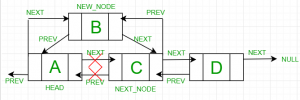链表( Linked List )
链表是一种线性数据结构,由一系列节点组成。每个节点包含两个部分,一个是存储数据的部分,另一个是指向下一个节点的指针。与数组不同的是,链表中的节点在内存中不一定是连续存储的。
链表可以分为单向链表和双向链表两种类型。在单向链表中,每个节点只有一个指向下一个节点的指针,而在双向链表中,每个节点有两个指针,一个指向前一个节点,另一个指向后一个节点。
链表的插入和删除操作非常高效,因为只需要修改节点的指针即可完成操作。但是,链表的访问操作需要从头节点开始,逐个遍历直到找到目标节点,时间复杂度为O(n),相比数组的O(1)访问时间要慢很多。
链表的优点是可以灵活地动态添加和删除节点,而且在内存管理方面比数组更加灵活。链表广泛应用于算法和数据结构中,例如链表可以用来实现栈、队列、哈希表等数据结构。
因为单链表比较简单,结构也比较单一,本篇文章就不做介绍
双链表 ( Doubly Linked List )

双链表 (DLL) 包含一个额外的指针 prev,以及 next 指针和链表中的 data
声明
我们以c++中的类为例
1
2
3
4
5
6
7
8
9
10
11
12
13
14
15
16
| class Node {
public:
int data;
Node* next;
Node* prev;
Node(int val) {
data = val;
prev = NULL;
next = NULL;
}
};
|
这段代码定义了一个名为 Node 的类,它表示双链表中的一个节点。该类具有三个成员变量:
int data:该节点存储的数据。Node* next:指向双链表中的下一个节点,它是一个指针类型。Node* prev:指向双链表中的前一个节点,它也是一个指针类型。
在双链表中,每个节点都有两个指针,一个指向前一个节点,一个指向后一个节点。因此,通过定义prev和next两个指针变量,该类实现了双链表节点的功能。
插入节点
可以通过四种方式添加节点:
- 在 DLL 的前面
- 在给定节点之后
- 在 DLL 的末尾
- 在给定节点之前
为了使用起来更方便,再声明一个名为 Doubly linked list 的类
1
2
3
4
5
6
7
| class DoublyLinkedList {
public:
Node* head;
DoublyLinkedList() {
head = NULL;
}
}
|
现在我们为它添加方法
在DLL头部插入

1
2
3
4
5
6
7
8
9
10
11
12
13
14
15
16
17
18
19
20
21
22
23
| void insertAtHead(int val)
{
Node* newNode = new Node(val);
newNode->data = val;
if (head == NULL)
{
head = newNode;
}
newNode->next = head;
head->prev = newNode;
head = newNode;
}
|
在给定位置之后插入

1
2
3
4
5
6
7
8
9
10
11
12
13
14
15
16
17
18
19
20
21
22
23
24
25
26
27
28
29
30
| void insertAfter(int pos, int val)
{
Node* current = head;
int count = 1;
while (count < pos - 1 && current != NULL)
{
current = current->next;
count++;
}
if (current == NULL)
cout << "Invalid position" << endl;
else
{
newNode->next = current->next;
newNode->prev = current;
if (current->next != NULL)
current->next->prev = newNode;
current->next = newNode;
}
}
|
如果你不知道之前节点的 prev 指针,那么就需要像上面这样从头开始遍历(或从尾 这里不细写了,思想是一样的)
如果要从知道的某一节点之后
1
2
3
4
5
6
7
8
9
10
11
12
13
14
15
16
17
18
19
20
21
22
23
24
25
| void insertAfter(Node* prevNode, int val)
{
if (prev_node == NULL) {
cout << "the given previous node cannot be NULL";
return;
}
Node* newNode = new Node(val);
newNode->next = prevNode->next;
prevNode->next = newNode;
newNode->prev = prevNode;
if (new_node->next != NULL)
new_node->next->prev = new_node;
}
|
在给定位置之前插入

1
2
3
4
5
6
7
8
9
10
11
12
13
14
15
16
17
18
19
20
21
22
23
24
25
| void insertBefore(Node* nextNode, int val)
{
if (nextNode == NULL)
{
cout << "the given next node cannot be NULL";
return;
}
Node* newNode = new Node(val);
newNode->prev = nextNode->prev;
nextNode->prev = newNode;
newNode->next = nextNode;
if (newNode->prev != NULL)
newNode->prev->next = newNode;
else
head = newNode;
}
|
在DLL尾部插入

1
2
3
4
5
6
7
8
9
10
11
12
13
14
15
16
17
18
19
20
21
22
23
24
25
26
27
28
29
| void insertAtTail(int val)
{
Node* newNode = new Node(val);
if (head == NULL)
{
newNode->prev = NULL;
head = newNode;
return;
}
Node* last = head;
while (last->next != NULL)
{
last = last->next;
}
last->next = newNode;
newNode->prev = last;
}
|
合并链表
我们可以声明一个函数,直接对类操作
1
2
3
4
5
6
7
8
9
10
11
12
13
14
15
16
17
18
19
20
21
22
23
24
25
26
27
28
29
30
31
32
33
34
35
36
37
38
39
| DoublyLinkedList mergeLists(DoublyLinkedList list1, DoublyLinkedList list2)
{
DoublyLinkedList mergeList;
Node* current1 = list1.head;
Node* current2 = list2.head;
while(current1 != NULL || current2 != NULL)
{
if(current1 == NULL && current2 !=NULL)
{
mergeList.insertAtTail(current2->data);
current2 = current2->next;
}
if(current2 == NULL && current1 !=NULL)
{
mergeList.insertAtTail(current1->data);
current1 = current1->next;
}
if(current1 != NULL && current2 != NULL)
{
if(current1->data < current2->data)
{
mergeList.insertAtTail(current1->data);
current1 = current1->next;
}
else
{
mergeList.insertAtTail(current2->data);
current2 = current2->next;
}
}
}
return mergeList;
}
|
打印
顺序打印
从头节点开始遍历,逐个打印
1
2
3
4
5
6
7
8
9
| void printList(DoublyLinkedList list)
{
Node* current = list.head;
while (current != NULL)
{
cout << current->data << " ";
current = current->next;
}
}
|
逆序打印
需要遍历到最后一个节点,再往前打印
1
2
3
4
5
6
7
8
9
10
11
12
13
| void printReverseList(DoublyLinkedList list)
{
Node* current = list.head;
while (current->next != NULL)
{
current = current->next;
}
while(current != NULL)
{
cout << current->data << ' ';
current = current->prev;
}
}
|
以上就是 使用C++中的类来完成对链表的基本操作
如果您发现有误,请在评论区留言或联系我
)















